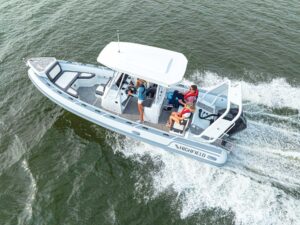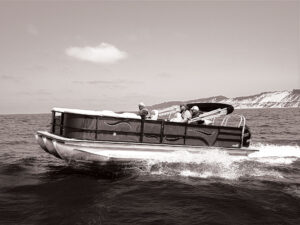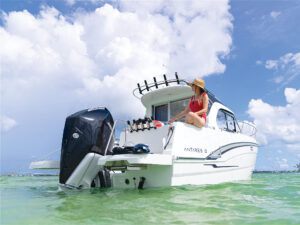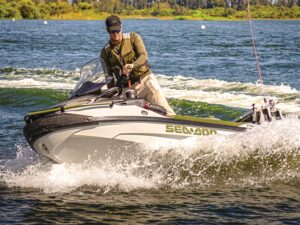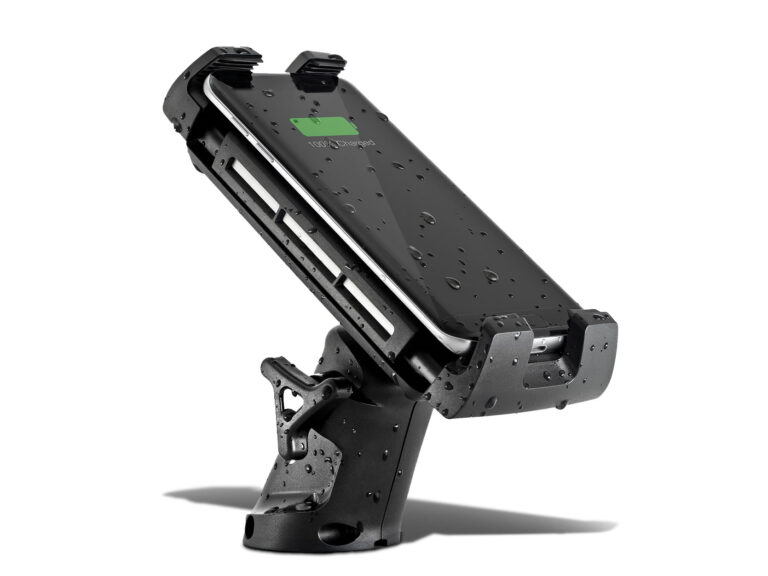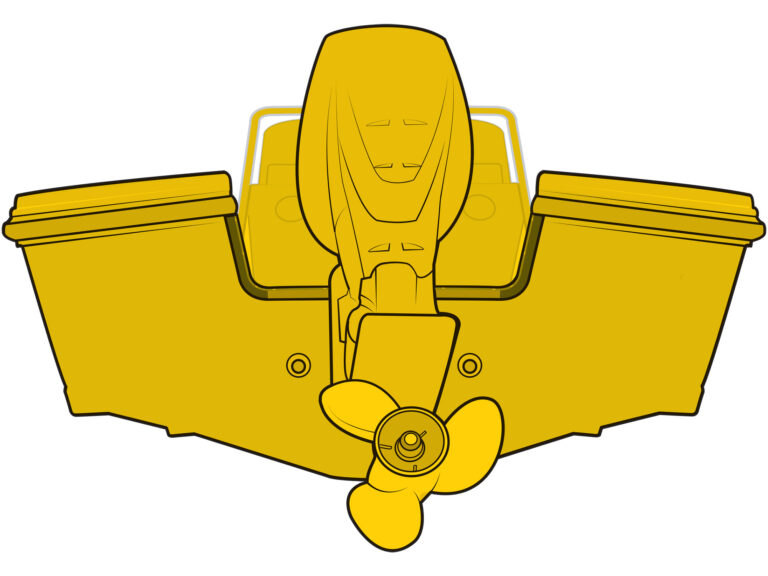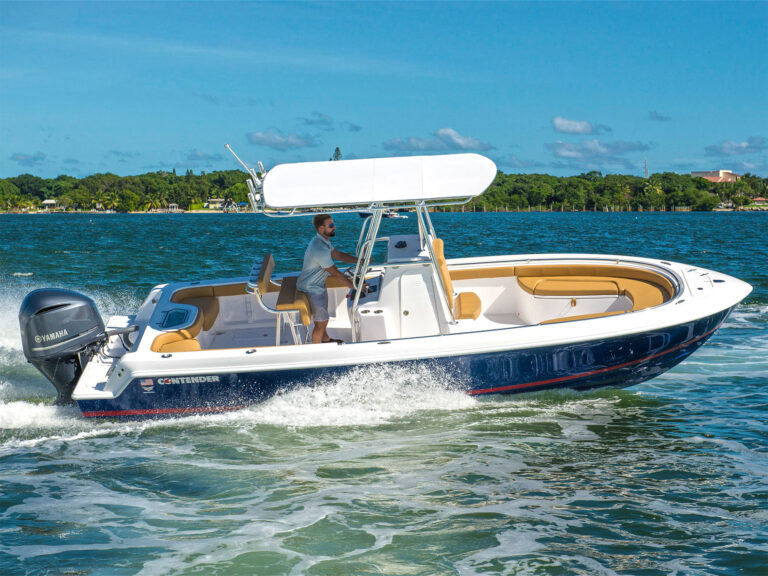Ethanol sucks! It’s a common refrain on engine maintenance blogs and is echoed in chorus in boatyards, marinas and waterside watering holes. You know E10 well by now — 90 percent gasoline blended with 10 percent ethyl alcohol. It’s been making its way around the country by federal mandate since 2005. In the years since, we’ve heard that E10 preys on boats — decomposed rubber parts and even burned pistons are among alleged crimes. Other accounts vary from clogged fuel filters to corroded metal and deteriorating fiberglass fuel tanks. Sometimes problems appear only in specific regions for a few months and vanish just as quickly. Stolen fuel economy has been added as evidence of ethanol’s dark side. But is ethanol guilty on all counts? Rather than reiterating public opinion, we interviewed experts and even put ethanol to the test — comparing it with straight gasoline in a 150 Verado and in a GMC pickup — with surprising results.
To ascertain ethanol’s effect on performance, we ran separate tests of a 2008 Boston Whaler 180 Dauntless with the 150 hp Verado, once on E10 and again on ethanol-free gasoline. The ethanol-powered motor showed a slight fall-off in our performance tests. At maximum throttle, the engine running on ethanol dropped only 10 rpm from when it ran on gasoline. Acceleration time from a standstill to 30 mph was off by a 10th of a second — about 2 percent.
Our fuel-flow numbers resulted in a similar gap between ethanol and straight gas. Economy fell off with E10 at a rate of a half-gallon per hour difference at 3,000 rpm, or $2 for every cruising hour.
Mercury engineers weren’t surprised at our performance or fuel economy results. The company’s engines are tuned to hit horsepower, torque and fuel-burn targets with either E10 or unblended gasoline. “We’re actually calibrating our engines slightly richer to protect the customer who burns E10,” says Tim Reid, director of engine design and development for both Mercury and MerCruiser. This protection is needed because E10 contains oxygen molecules not present in straight gasoline. For a preset ratio of air and fuel, E10 burns leaner, increasing cylinder and exhaust temperatures. Adding a bit more fuel to richen the mix cools things down with E10, but wastes a bit of fuel when burning straight gasoline.
As for the charge of burned pistons, most engines that were built before E10 was being considered were tuned a bit rich from the start. While they might be damaged by higher blends of ethanol, E10 actually helps these engines run cleaner. “We’re monitoring parts [purchased] on these legacy engines,” Reid says, “but we’re pretty confident the legacy fleet is safe with E10.”
Remember that boats had fuel problems long before E10 came along, and that the vast majority of boats switched to ethanol without a hiccup. Those that didn’t caused the current stir. Many problems have arisen because ethanol is a polar solvent — electrically charged to make or break chemical bonds much the way magnets repel or attract each other. Gasoline is comprised of mostly nonpolar compounds.
“I think it’s the interaction that’s causing the problems,” says Frank Kelley, Mercury marine’s fuels and lubricants specialist. This interaction strips years of gasoline varnish from the inside of fuel tanks, rapidly clogging fuel filters. It also rankles engineers who for decades assumed strong polar solvents like ethanol wouldn’t find their way into fuel. High-end builders, for example, preferred fiberglass fuel tanks, since they would — and did — outlast aluminum tanks many times over. But ethanol breaks down polyester resins, destroying tanks built in the ’60s, ’70s and ’80s and ruining attached engines in just weeks.
Rubber and plastic engine components were likewise formulated to withstand gasoline, but not ethanol. “We made the transition in the 1980s,” Reid says. “Elastomers and compounds in O-rings, gaskets, fuel lines [were] redesigned for ethanol.” What about engines built before then? If an engine hasn’t visited the mechanic much in two decades, the switch to E10 might be a good time for longterm maintenance items such as replacing hoses, rebuilding carburetors or checking fuel pumps. But assuming normal maintenance, neither Reid nor any mechanic interviewed sees a need to rebuild fuel pumps, carburetors or other components before they act up. “If it’s my money, I’d run it,” Reid says. “If it starts to act funny, doesn’t run quite like it always did, then I’d take it in for service.”
Ethanol does have innocent victims. My brother-in-law filled his 10-year-old 30-foot center console with E10 and then ran to his slip. A few days later my wife and I ran the boat barely two miles before deteriorated hoses choked its 225 Optimax outboards to a sputter. While the boat shouldn’t have fallen victim to ethanol, our Florida Keys vacation was a fatality. The inner liner of the fuel hose simply fell apart, clogging the fuel system. Jim Lawrence of J&B marine in Tavernier, Florida, had seen it before. “I found particles and pieces in the [fuel] filter,” Lawrence says. “Particles from the fuel tank should be flat, but these had a radius to them. When I pulled the hose off, it was pretty obvious.” In fact, rubber hose deteriorations are plaguing Floridians on boats only three years old.
So why does ethanol attack supposedly resistant hoses? “Ethanol changes the chemical environment,” Kelley says. Years of soaking in ordinary gasoline and exposure to heat, cold and sun also affect hose chemistry unpredictably. “It would be awfully difficult to replicate [those conditions in a laboratory],” Kelley says. Still, he doesn’t see this as the likely cause for hose problems in South Florida. Instead, he blames phase separation, which occurs because polarized water molecules bond with polarized ethanol. In small quantities, the two stay suspended in gasoline, but add too much water and the mixture separates and settles. “We’ve always had phase separation. When you don’t have ethanol, it can take a few parts per million to get phase separation,” Kelley explains, meaning water in the bottom of gasoline tanks years ago also contained polar compounds from the gasoline. “With E10, instead of a few hundred parts per million of something coming out of the gasoline, it’s more like 5,000, 6,000, 7,000 parts per million. There’s no place for that amount of material to hide.”
Kelley says the resulting cocktail expands anywhere from two to eight times beyond the original volume of water. “It gets sucked up into the engine. It doesn’t burn, and the combination of water and ethanol is extremely corrosive.”
Phase separation might explain the geographic or sporadic nature of some problems. Two years ago on Long Island, for example, boats that had been running E10 for years suddenly had hose problems identical to those in the Keys. That also happened to be a particularly rainy summer. South Florida is certainly prime territory for water in fuel, but problems occurred even when tanks seemed fine. The key might be that phase separation is temperature dependent. Lake water and seawater buffer temperatures in fuel tanks, but fuel in hoses, filters, carburetors, fuel pumps and vapor separator tanks may phase-separate when temperatures drop — these are costly components that are inexplicably failing on boats using E10. “You’re getting a concentration of all things that damage polymers,” Kelley says.
If water is the underlying problem, is it fair to blame ethanol? New Hampshire’s Lake Winnipesaukee only recently switched to E10, but mechanics there have been fighting water in fuel for years. “A lot of the old carbureted engines could handle a bit of water, but with today’s engines, once it fills up the filter, it stops the motor,” says Jeff Fay of Fay’s Boatyard in Gilford, New Hampshire (faysboatyard.com). “It doesn’t do a lot of damage [in unblended gasoline],” Fay says. “If water sits in an engine for a while, it can damage the fuel system. Some aluminum tanks get pinholes in the bottom [where the water collects]. That’s a problem with or without ethanol.”
South Florida also has long had problems with water in fuel. “My phone has been ringing off the hook for 35 years. Ethanol just made it ring more,” says Skip Trent, whose business is removing contaminants from gas and diesel tanks from Miami through the Florida Keys. “There are only four ways water can get into a tank: through the vent, through the fill, around the [fuel gauge] sender or from a hole in the tank.” Loose gauge senders or improperly plumbed vents are common culprits. Water enters fills when oversize mounting screws, like oval or pan-head, protrude so high they keep fill caps from sealing, or when cracked or missing cap O-rings go unnoticed. Some brands of plastic fills — even on expensive boats — crack from sun or overtightening. “Every time it rains, you might as well have a funnel in the fill,” Trent says.
Unfortunately, when E10 phase-separates, it loses one or two octane points, so it has to be discarded. “With [unblended] gasoline, I could clean your fuel and tanks and return the good fuel. You’d lose maybe 10 gallons,” Trent says. “Now, if I test it and it [contains] ethanol, I’m going to dispose of [all] this material.” (Leave tank cleaning to trained professionals with proper equipment, though. Shop-Vacs and water pumps can ignite gasoline fumes.)
Again, phase separation, corroded tanks and clogged filters are exceptions, not the norm. “I’m not big on taking things apart just to take them apart,” says Rick Panasuk of Ocean Spray marine Service in Bellmore, New York. “We’ve had ethanol here for five years now. It isn’t necessary to spend hundreds of dollars needlessly.”
Monitor rubber hoses and check for water in tanks. Beyond that, Panasuk says, any change from “normal” warrants service. Low power might indicate clogged fuel filters or injectors. Fuel-injected engines that stutter at high speed should visit a mechanic, as should carbureted engines that don’t accelerate smoothly from idle. Ethanol causes hard starts when cold, but once warm, engines shouldn’t stall. “Spin off the water separator after the first run of the season and check for water,” Panasuk says. He also warns that ethanol problems are worse on boats that sit. “The guy using his boat lightly really needs to do more.”
In short, ethanol requires boaters to think about fuel instead of putting it in the tank and going. Considering the consequences of a fuel leak or water-related problems — with or without ethanol — added attention to fuel systems is a good thing. When ethanol comes to town, it can cause its share of problems, but given the facts across the board, for most boaters it doesn’t necessarily suck as bad as you might have thought after all.
Seven Tips for Living With Ethanol
[1] Check and drain water separators regularly. Enough water will cause phase separation, even within the filter.
[2] Inspect rubber parts, primer bulbs and fuel hoses — even ethanol-resistant hoses marked J-1527 — for swelling, softness or cracking. With electricity and fuel turned off and a bucket to catch spills, check fuel hose innards too.
[3] Monitor fuel tanks, vents, fills and gauge sender gaskets for water leaks, and check bilges for gasoline.
[4] Advice is mixed on fuel storage levels. Full tanks don’t breathe much as temperatures change, so a full tank of ethanol is less likely to absorb moisture from humid air, but E10 shouldn’t sit unused.
[5] Stabilizers seem to mitigate many problems. Use recognized brands labeled for E10, like those from StarTron (startron.com), ValvTect (valvtect.com) and Sta-Bil (goldeagle.com), particularly if fuel won’t be used completely in a week or two.
[6] Don’t switch frequently between E10 and unblended gas.
[7] Learn your engines’ normal noises and proclivities, and see a trusted mechanic at the first sign of change.
4.4gph: The fuel burn at 3,000 rpm with ethanol running through a 150 hp Mercury Verado on a Boston Whaler 180 Dauntless. Straight gas ran at 3.9 gph. In our test it was a hard-to-hold 3,000 rpm. The tach wanted to constantly fall with ethanol and constantly rise with unblended fuel. Mercury engineers say ethanol’s decreased energy will show most noticeably as decreased torque — exactly what we saw at 3,000 rpm.
1 mile: Extra distance achieved per gallon of E10 compared with unblended fuel when driving my 2008 GMC Sierra without a trailer. Mileage was nearly identical when towing an 8,100-pound load. Automobiles have far fewer problems with ethanol than boat engines do because fuel systems are closed to outside air and because entire tanks of fuel are burned and filled more regularly. Still, mileage was supposed to decrease by about 2 percent with the ethanol. Weather differences could have been a factor, as could the wintertime blend of E10 I tested versus the summertime blend of gasoline, or even the way the truck’s sensors were responding. All of this underscores the fact that ethanol ranks low on the list of factors when it comes to fuel economy.
10,000: Estimated number of boats with polyester-fiberglass tanks. If you have one, never use ethanol. Test a sample at each fueling with a few drops of dye that disperses in ethanol or water but not gasoline. Better yet, replace your fuel tank, because straight gas isn’t widely available these days.

